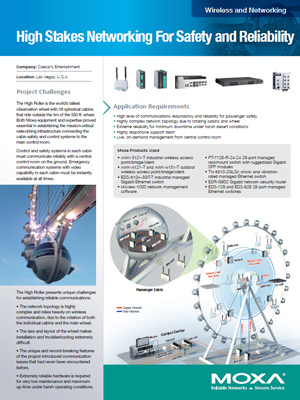Continuous Operation for the Las Vegas High Roller.
The world’s tallest observation wheel, the 55-story High Roller in Las Vegas, leverages industrial wireless and self-healing fiber-optic networking equipment for position tracking and control. This is no ordinary Ferris wheel. The High Roller is part of a $550 million investment project by Caesars Entertainment, and can carry 40 people per cabin in the 30 minute ride, more than 2,200 passengers per hour.
Designing this record-breaking attraction required the involvement of top engineering design experts including leaders from theme park, bridge-building, gondola, and civil engineering industries. Within each cabin were a number of control and safety systems that communicated with the central control room on the ground. There were also emergency communication systems with video capability in each cabin that needed to be available at a moment’s notice at all times. Finally, in-cabin entertainment, position tracking, and wireless networking were essential towards delivering a quality passenger experience over the 30-minute duration of the ride. Due to the critical nature of these systems, wireless communications from each cabin to the main wheel and from the wheel to the ground needed to perform with the utmost reliability.
Challenges
Establishing reliable communications was exceptionally challenging for the following reasons:
- The new state-of-the-art control and emergency systems required a high level of communications redundancy and reliability to ensure passenger safety.
- The network topology was highly complex and relied heavily on wireless communication, due to the rotational movement of both the individual cabins and the main wheel.
- The sheer size and physical layout of the wheel made installation and troubleshooting extremely difficult, especially after cabins were installed.
- The unique and record-breaking features of the project introduced communication issues that had never been encountered before and were not revealed during initial testing.
Overcoming these challenges required a combination of networking expertise, the right equipment, and a flawlessly executed network topology. Find out how these challenges were addressed and downtime was reduced by downloading our case study.
Have a question about this case study? We would love to hear from you. Please feel free to contact us and one of our representatives will reach out to you with more information.
